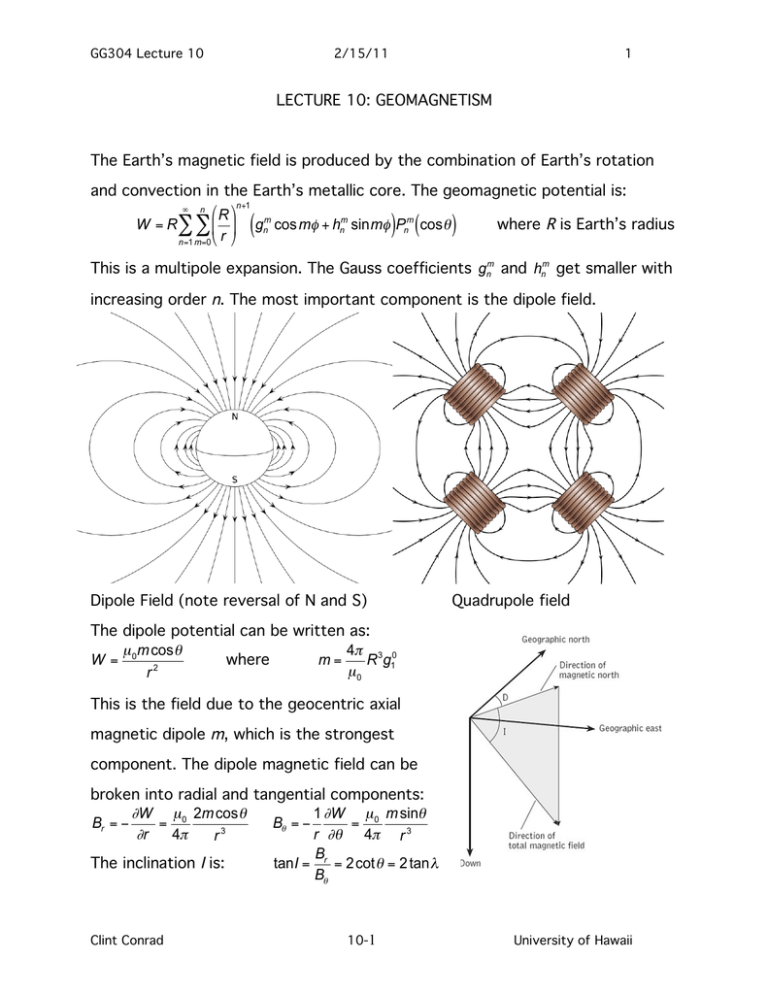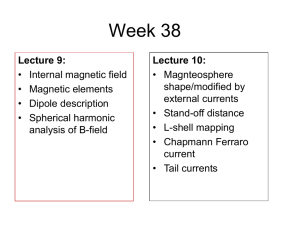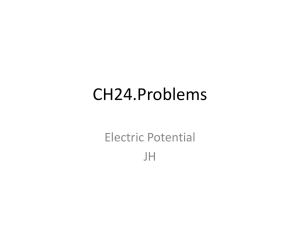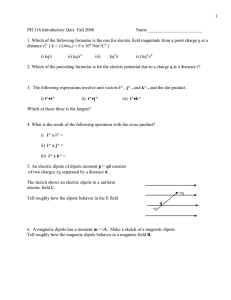LECTURE 10: GEOMAGNETISM The Earth`s magnetic field
advertisement

GG304 Lecture 10 2/15/11 1 LECTURE 10: GEOMAGNETISM The Earth’s magnetic field is produced by the combination of Earth’s rotation and convection in the Earth’s metallic core. The geomagnetic potential is: n+1 + n " R% where R is Earth’s radius W = R( ( $ ' gnm cos m) + hnm sinm) Pnm cos * n=1 m=0 # r & ( ) ( ) This is a multipole expansion. The Gauss coefficients gnm and hnm get smaller with ! increasing order n. The most important component is the dipole field. ! Dipole Field (note reversal of N and S) ! Quadrupole field The dipole potential can be written as: 4" 3 0 µ m cos " m= R g1 W= 0 2 where µ0 r This is the field due to the geocentric axial ! magnetic dipole m, which ! is the strongest component. The dipole magnetic field can be broken into radial and tangential components: #W µ 0 2m cos % 1 $W µ 0 m sin" Br = " = B" = # = 3 #r 4$ r $" 4% r 3 r B tanI = r = 2cot " = 2 tan # The inclination I is: B" ! ! Clint Conrad ! 10-1 University of Hawaii GG304 Lecture 10 2/15/11 2 Earth’s field is measured in nT (nanoTeslas), and can be separated into Inclination (I) and Declination (D). Deviations from a dipole field are caused by non-axial dipole components and higher-order components. Intensity (nT) Inclination (degrees) Declination (degrees) The Earth’s field has several non-dipole complexities, and changes with time: -- The magnetic poles are not exactly opposite each other. -- The magnetic field is stronger near high latitudues (weakest over S. Atlantic). Clint Conrad 10-2 University of Hawaii GG304 Lecture 10 2/15/11 3 -- Strength of the dipole field is decreasing at 3.2%/century from 1550 to 1900 and then accelerated to 5.8%/century for last 80 years (would be zero in year 4000 – the beginning of a geomagnetic field reversal?) -- The location of geomagnetic pole is changing with time. -- The dipole field drifts westward at 0.044-0.14°/yr (2500-8000 yr period). -- Non-dipole surface features drift westward 0.2-0.7°/yr (550-1650 yr period). -- The magnetic field polarity reverses periodically. Paleomagnetism is the study of geomagnetic field recorded in rock magnetizations. Remenant magnetism of rock samples is measured using an: astatic magnetometer (rarely), a spinner magnetometer, or a cryogenic magnetometer (most sensitive). Dipole and non-dipole components of the magnetic field average to zero over timescales of 104 yr, thus rocks that average the field over longer timescales longer than ~104 yr, and only the average dipole field remains (axial geocentric dipole hypothesis). Using the inclination (I), the paleomagnetic pole can be computed – many observations yield an average pole near the geographic north pole. To determine if a set of paleomagnetic poles is representative of the field at the time of formation, several tests have been developed: Clint Conrad 10-3 University of Hawaii GG304 Lecture 10 2/15/11 4 Fold test: “undo” the fold to see if orientations align. Baked contact test: If country Rock orientations are the same as those within an intrusion, then field has not changed since intrusion. Reversals test: If a reversal happens between samples, the paleomagnetic poles should be exactly opposite each other. Tectonics can be inferred from Paleomagnetic data. If a tectonic plate has moved, since the remanent field was recorded, then the inclination (I) gives the distance to the virtual geomagnetic pole and the declination (D) can be used to position it. Poles for different ages trace an apparent polar wander path that can be linked to plate motions. Each continent has its own polar wander path. Geomagnetic polarity reversals (switching of the orientation of the geomagnetic field) occur with varying frequencies, take place over ~3000-5000 yr, and can be used to calibrate seafloor age. Plate tectonic reconstructions can be deduced from seafloor age maps. Clint Conrad 10-4 University of Hawaii




